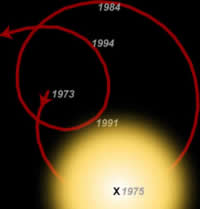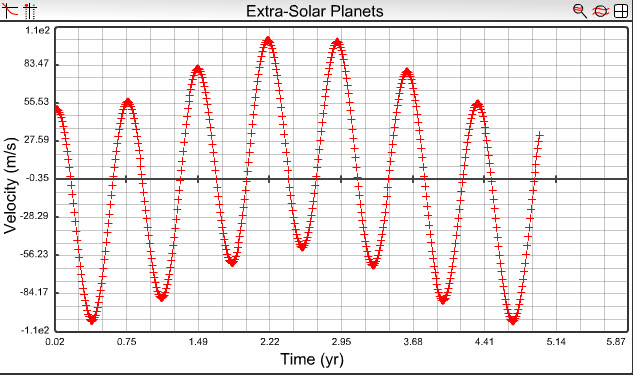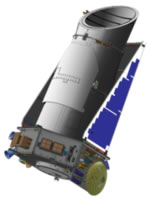Planets Around Other Stars
439 - 446
In 1995 astronomers finally succeeded in providing what most consider to be convincing proof that planets orbit stars other than our Sun. By December 2017, 3710 exoplanets in 2780 systems have been found (with as many as 5000 additional "candidates"). In this section you will look at the evidence for exoplanets as well as how they are detected.
The First Clue - Protoplanetary Disks
According to the Solar Nebula Theory, planets form out of the accretion disk that also gives birth to the parent star. If this is so, then we should expect to see evidence for such accretion disks in area in which new stars are forming. Excellent evidence for this came in the 1990's with the imaging capabilities of the Hubble Space Telescope.
Example 16.8 Examine the following Hubble Space Telescope images and explain how they are consistent with the Solar Nebula Theory and also the conjecture that there are planets around other stars.
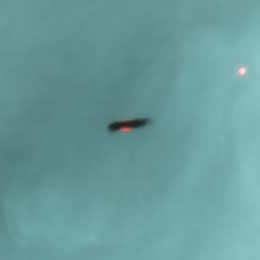 |
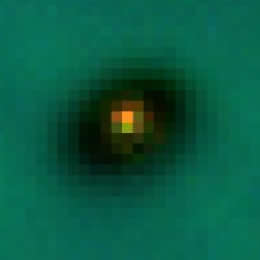 |
 |
| Figure 16.13a A protoplanetary disk in the Orion Nebula Credit: J. Bally (University of Colorado) and H. Throop (SWRI) | Figure 16.13b Image of a new star surrounded by its accretion disk. Credit: C.R. O'Dell/Rice University;NASA |
Figure 16.13c Described as an "Interstellar Frisbee" this is an edge-on view of a protoplanetary disk that is about 17 times the diameter of our present solar system. Credit: Mark McCaughrean (Max-Planck-Institute for Astronomy), C. Robert O'Dell (Rice University), and NASA |
Solution: The images all show disks of material around newly formed stars in the Orion star forming region. The disks are accretion disks which is predicted by the SNT as the first stage in formation of a star and its planetary system. This also demonstrates that there is a large amount of material left-over after formation the star and thus available for planet formation.
Disks of material around new stars ( also sometimes called debris disks or circumstellar disks) are common and represent some of the earliest known evidence for exoplanets. They do not, however, by themselves "prove" the existence of exoplanets.
Detecting Exoplanets by the Doppler Effect
In a previous Chapter (see Chp 8, pg 145) you learned that a pair of stars orbit around their common centre of mass. This is also true of our Sun and its planets. The centre of mass of our solar system is a point usually just below the Sun's surface and the Sun executes a subtle dance around this point. Because there are many masses in the solar system the motion is an elaborate combination of small, nearly circular motions. Figure 16.14 shows the motion of the Sun around the Solar System's centre of mass over a 20 year period.
| Figure 16.14 |
This motion is very subtle and causes the Sun (or a distant star) to move relative to a distant observer. This subtle motion produces a Doppler shift in the spectral lines of the star which can, in principle be detected spectroscopically.
Example 16.9 An astronomer on a distant star system suspects that our star (Sol = "the Sun") may have a planetary system. Use the applet in Figure 16.14 to estimate, roughly the speed with which the Sun moves around its centre of mass.
Solution: If you look at the motion of the Sun between 1975 and 1984 (9 years) you can see that it moves through approximately 2 times its diameter.
As Example 16.9 illustrates, the motion of our Sun is very small. Recent advances in spectroscopy, however, have made motions on the order of a few 10's of m/s detectable and this has provided a very powerful technique with which astronomers can detect planets around other stars. The first exoplanet to be discovered was found in 1995 orbiting the star 51 Pegasi. Figure 16.15 shows the radial velocity curve constructed for this star. Models suggest that a planet of about 1/2 the mass of Jupiter orbits this star at a distance of only 0.05 AU! |
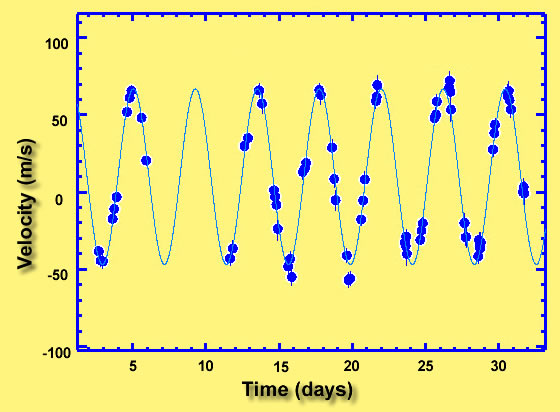 |
| Figure 16.19 Radial velocity curve for 51 Pegasi (adapted from Marcy and Butler). |
Simulating Motion of Exoplanets
Figure 16.20 provides you with the applet "Exoplanet" that you can use to demonstrate how the "wobble" produced by orbiting planets will lead to a detectable motions in the parent star. With this applet you can add (by dragging onto the solar system) up to 3 planets. You can also enter the mass of the parent star as well as the individual masses of the planets.
Example 16.10 Shown below is a radial velocity curve for the star HD12661. This star is about 100 ly away and has a spectral type G6V which means it is quite similar to our Sun. The mass of this star is 1.1 Mo. Use the applet Exoplanet to show that this could be modeled as a star with two planets. Try to estimate the mass and position of each planet.
| Solution: This is not easy and one normally uses sophisticated mathematical techniques to do this. However - by looking at the radial velocity curve you can see that there are two very different patterns present. One is rapid variation that occurs 6 times over a span of about 4.5 years. The other is a more gradual variation that takes about 4 years to complete. WHat this tells you is that there are two planets with periods of about 0.7 years and 4.5 years. | 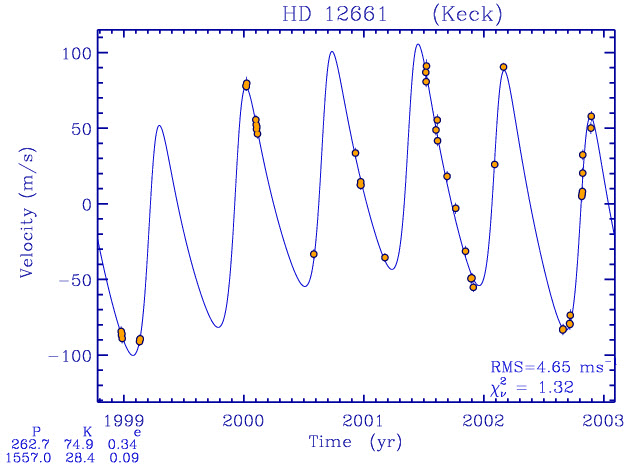 |
|||||||||||||||
To use the applet first set the star mass to equal 1.1 Mo. Next drag two planets onto the solar system and move them toward the star. Press the "Make System" button and observe what the period is for each planet. Adjust the position until you have one planet with a period of 0.7 years and another with a period of 4.5 years. When you do this successfully you will discover that one of the planets must be quite close to the Star at a distance of 0.7 AU while the other is at a distance of about 2.7 AU. Now you need to assign masses to the planets. Experiment a bit but note that the maximum velocity is 100 m/s. It will take a while but you should be able to zero in on the following as reasonable estimates:
|
||||||||||||||||
Detecting Planets by Transits
Another way in which planets can be detected around distant stars is to observe the effect that they have on the brightness of the star when the planet eclipses the star. The more correct term for this is transit. A planet transits the star when it passes in front of the star. Figure 16.22a shows the variation in brightness of the star HD 209458 as a planet transits. Over the span of about 3 hours the planets blocks enough light from the star for its brightness to change by a fraction of a percent or a few thousandths of a magnitude. Figure 16.22b illustrates this with point "b" and "d" corresponding to the start and end of transit. By the end of 2009, more than 60 planets have been discovered by observing their transits. Figure 16.22c shows a "typical" exoplanet light curve captured at the Athabasca University Observatory( February 2014) showing the transit of an exoplanet around Qatar1 - a K dwarf star in the northern constellation Draco. The planet is most likely a gas giant, about 12.77 times the size of earth and having a surface temperature of 1389K and an orbital period ("length of year") of only 1.42 days!
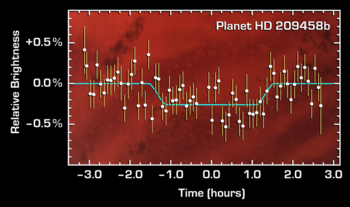 |
 |
| Figure 16.22a Transit of a planet around the star HD 209458 | Figure 16.22b The transit of a planet around a distant star |
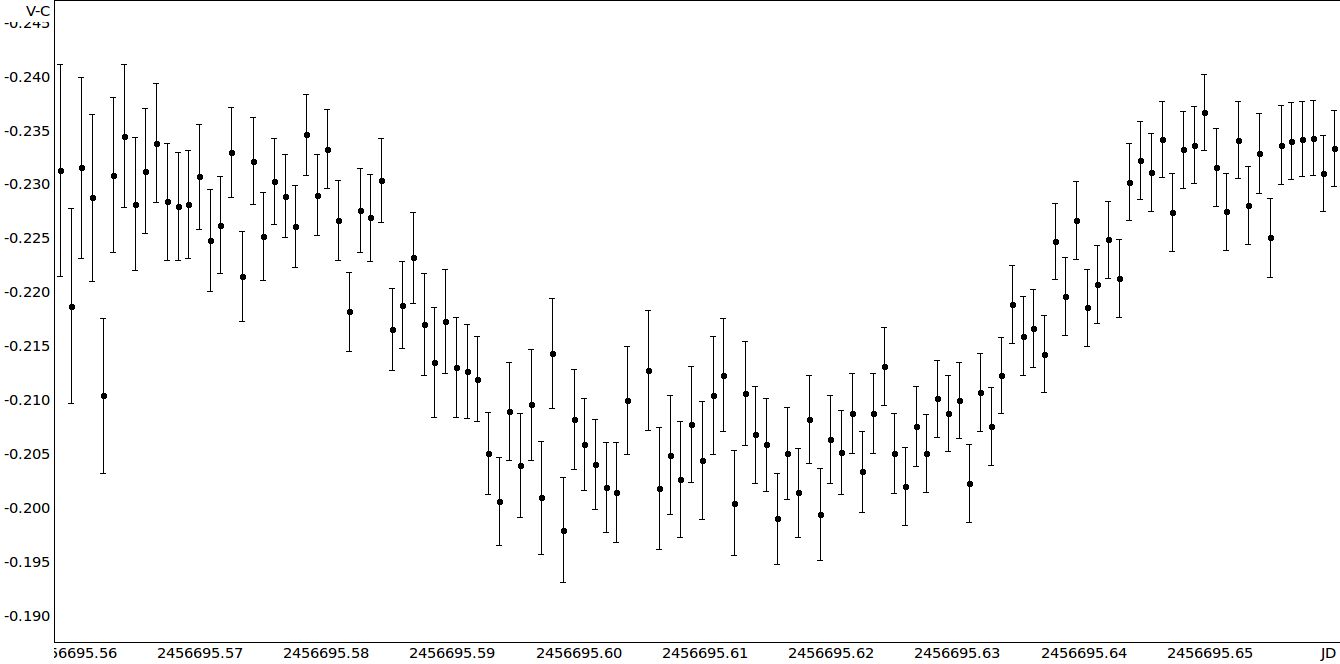 |
|
| Figure 16.22c The transit of a planet around Qatar1 (Data courtesy Athabasca University Observatory - Martin Connors) | |
Detecting Planets by Direct Observation
Dramatic improvements in imaging technologies over the past decade have now made it possible to directly observe planets orbiting distant stars. One of the most significant of these is the Gemini Planetary Imager (GPI) which is collaborative project of Canadian and American astronomers. The GPI uses one of the most sophisticated adaptive optics systems ever constructed and is designed to work in the infrared region of the spectrum. Figure 16.23 shows a remarkable image taken with the GPI on the 8 m diameter Gemini North telescope of the W. M. Keck observatory in Hawaii.
| In this figure the star HR 8799 is shown surrounded by 3 planets. The dark, central circle is an occulting disk - a mask that blocks the light from HR 8799 and allows the planets to be seen. Also note the scale shown on the lower left. This is an extremely high resolution that not only requires the exceptionally steady skies of Mauna Kea, Hawaii but also the adaptive optical corrector of the Gemini Planet Camera. This is image is from a study led by Christian Marois of the National Research Council of Canada’s Herzberg Institute of Astrophysics (Victoria B.C., Canada). |  |
| Figure 16.23 Discovery image of 3 planets around the star HR 8799. Credit Gemini Observatory/NRC.AURA; Christian Marois et al. |
Other Ways to Detect Exoplanets
There are many different and often complimentary techniques that astronomers can use to search for exoplanets. These are summarized below in Table 16.6
Technique |
Description |
Number of detections |
| Astrometry | This was one of the first techniques tried and attempts to directly observe the "wobble" of the parent star around the planetary system centre of mass | 1 |
| Radial Velocity | This is a proven successful technique. It measures the velocity of the parent star as it wobbles around the centre of mass. | >385 |
| Transit Method | The most successful technique - works when the orbital alignment allows us to see transits (eclipses) by the planets. | >800 |
| Pulsar Timing | If a planetary system exists around a pulsar the influence of the planets and wobble of the pulsar around the centre of mass will lead to detectable variations in arrival time of the pulsar signal. | 9 |
| Gravitational Microlensing | Large planets will warp space enough to produce a brightening (lensing) in the parent star | 10 |
| Circumstellar Disks | This is a long-known indirect test for exoplanets. For exoplanets to exist there must, at some time in the history of the system been an accretion disk. | indirect |
| Direct Imaging | A new and burgeoning technique which provides, perhaps, the most compelling evidence for exoplanets | 11 |
| Spectral Contamination | Some white dwarf spectra are contaminated by elements that should not exist in a WD. Lines of magnesium and calcium detected in some WD's suggest that this may be material (perhaps asteroidal or cometary) that has "contaminated" the atmosphere of the WD. | indirect |
| Table 16.6 Summary of detection methods used to find exoplanets. | ||
Jupiter-Sized Planets and Selection Effects
To date the planets that have been discovered are all Jupiter sized gas giants. Some of these are closer to the sun than Mercury and orbit their stars in a matter of days. This poses a number of puzzles. One puzzle is why are all the planets massive? The answer, as Example 16.11 shows is straight forward.
Example 16.11 Use the exoplanet applet to estimate the radial velocity that you would expect to be produced by an earth-like planet orbiting its parent star at a distance of 1 AU.
Solution: If you set the star mass at 1 Mo, and make the mass of the planet 1earth mass or 1/300th MJ you will see that the radial velocity is only on the order of 0.1 m/s which is still far below the limit of detection using radial velocity measures.
As Example 16.11 illustrates, we find Jupiter-sized planets because they are big enough to create measurable changes. This does not mean that there are no "earth-like" planets. The predominance of Jupiter-like planets is a selection effect.
The detection of many Jupiter-sized planets so close to their parent stars also poses a serious problem for the standard "Solar Nebula Theory" of planet formation since we would not expect gas giants to be able to form so close to their stars in, presumably a hot environment.
The Future of Exoplanetary Astronomy - Looking for "Earthlike Planets"
Finding an exoplanet with a mass similar to that of Earth and a distance from its parent star more similar to the 1 AU separation between the Earth and Sun is a key goal for exoplanetary astronomy. In late 2009 NASA launched the Kepler telescope which is a specially designed 0.95 m telescope that will use the transit method to detect exoplanets. Its goal is to look for possible Earth-sized planets in a sample of over 140 000 stars. The data collected by Kepler will eventually guide the NASA proposed Terrestrial Planet Finder mission. This mission (or perhaps the European Space Agency Darwin mission) will attempt to obtain spectra of terrestrial-like planets with a goal of detecting an Oxygen atmosphere which could be an indicator of the presence of extraterrestrial life.
Practice
- Explain why the detection of protoplanetary disks may be a necessary but not sufficient condition for the existence of exoplanets.
- Use the applet Exoplanet to create a radial velocity curve for the following system around a star of mass 1.5 Mo:
PlanetMass (MJ)Orbital distance (AU)A1.11.2B5.16.1C8.17.5 -
Look at the following radial velocity curve for a star suspected of having a planetary system. See if you can create a model for this system and "discover" the exoplanets. (Use the applet Exoplanet to assist you). How many planets do you think there are? Explain.
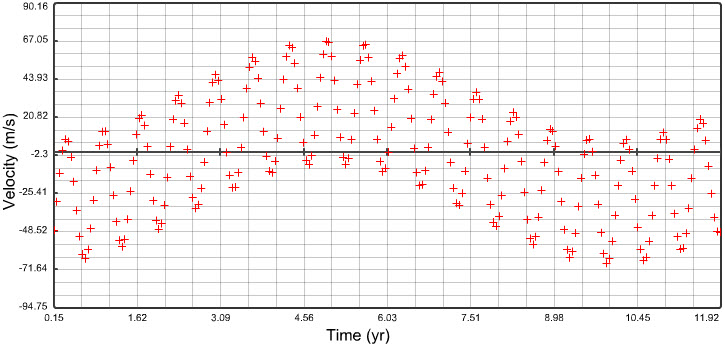
- Explain why the discovery of many Jupiter-sized planets very close to their parent stars is a problem for the standard Solar Nebula Theory of planetary formation.
- Would the transit method favour the detection of Jupiter-sized planets over Earth-sized planets? Explain.
- Which would "wobble" more due to the presence of a planetary system - a low mass star or a high mass star. Explain.

To understand how planets are detected around other stars
Chp19.4
Extrasolar planet or exoplanet is the name given to a planet that orbits a star other than our Sun.

barycentre.



